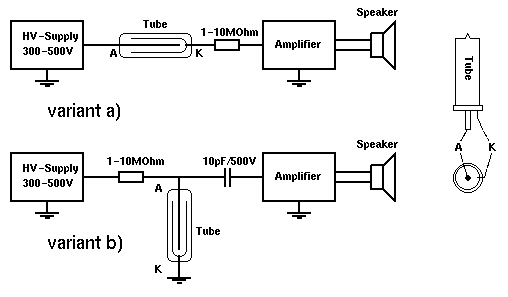| Jochen's High Voltage Page |
Geiger counters are devices to detect and measure ionizing radiation, as emitted by radioactive sources. The heart of a geiger counter is the Geiger-Mueller-Tube (GM tube). This is a gas filled tube, to which a voltage of several 100V is applied. Normally, the gas insulates and no current is drawn. When a radiation particle or quantum passes the tube, it triggers a gas discharge, i.e. the gas becomes conducting. The resulting current pulse can be amplified and indicated visibly or audibly ("clicking").
The GM tube is the most expensive and most difficult to obtain part or a geiger counter. There are two main types of tubes:
Geiger counter circuits can be bought complete or as kits from many electronic and surplus stores, often cheaper than a GM tube alone. An integrated electronic counter is very useful. The electronic circuit of a geiger counter (hv generation and amplifier) is fairly easy to build, and there are many more or less detailed plans around. Some are available in my archive.

|
Schematic geiger counter circuits. Variant (a) is frequently found in kits and home-brew designs, because the necessary amplifier is less demanding. Variant (b) has the advantage of proper grounding and shielding of the tube. |
The number of pulses ("clicks") over a certain time (count rate) is a quantitative measure of radiation. The count rate (often in cpm = counts per minute) depends, among others, on the geiger mueller tube, the type and energy of radiation and the geometry of the measurement, and therefore is difficult to convert to dose rate (Sv/h) or activity (Bq or Ci). However, it can be used as a relative measure to compare radioactive sources.
Some commercial geiger counters are "calibrated" to diplay the dose rate in µSv/h or mR/h directly, but unless the device is a really professional one, this is quite inaccurate for the reasons stated above. It may be useful to get a rough estimate of the dose rate, but it may also be dangerously misleading in some cases (in particular for low-energy x-rays).
| [Index] | [Links] |
This document is copyrighted. All rights reserved. No part of this document may be reproduced without my permission. Permission to copy and publish this document or parts of it on the WWW is granted until explicitely revoked, under the condition that it is accompanied by this or a simliar copyright notice, including my name and the original URL.